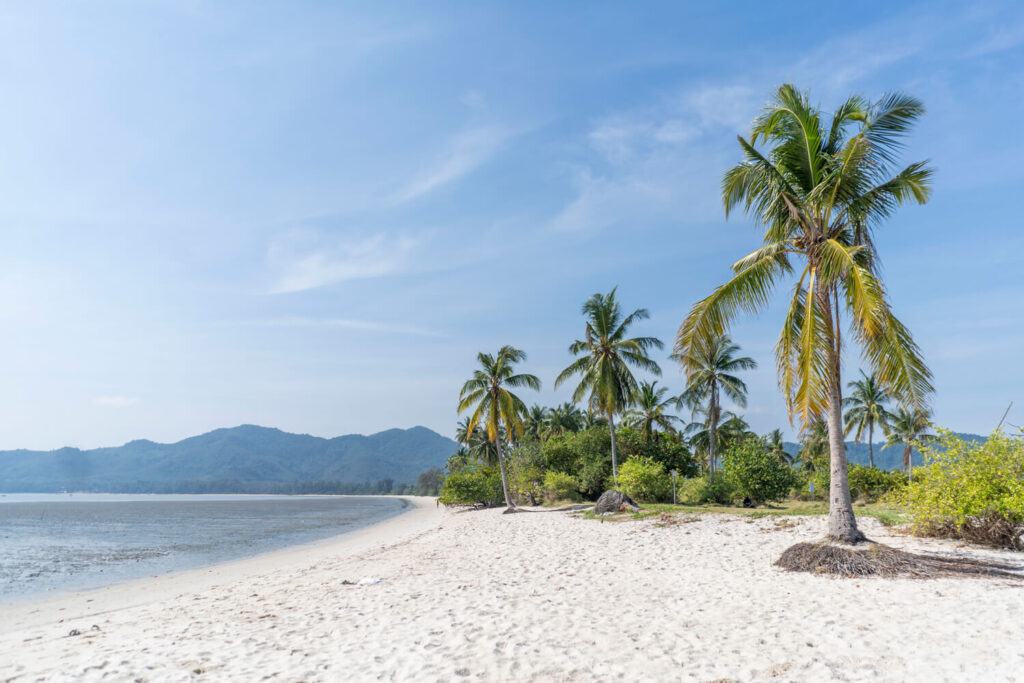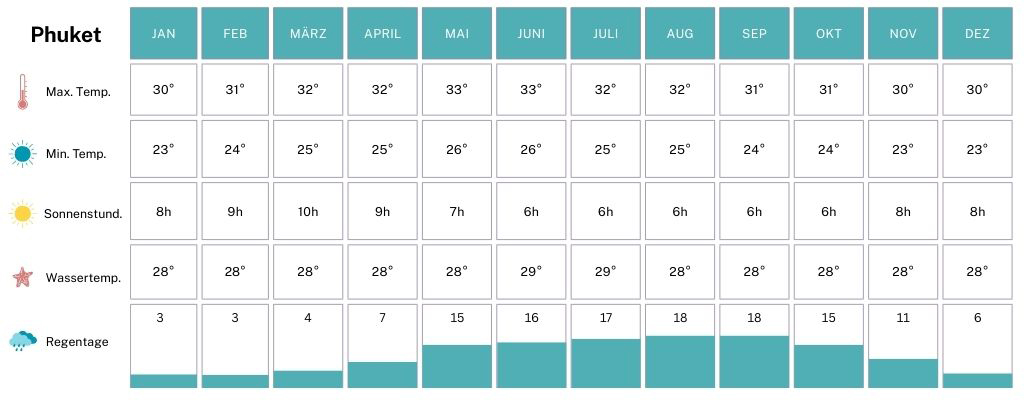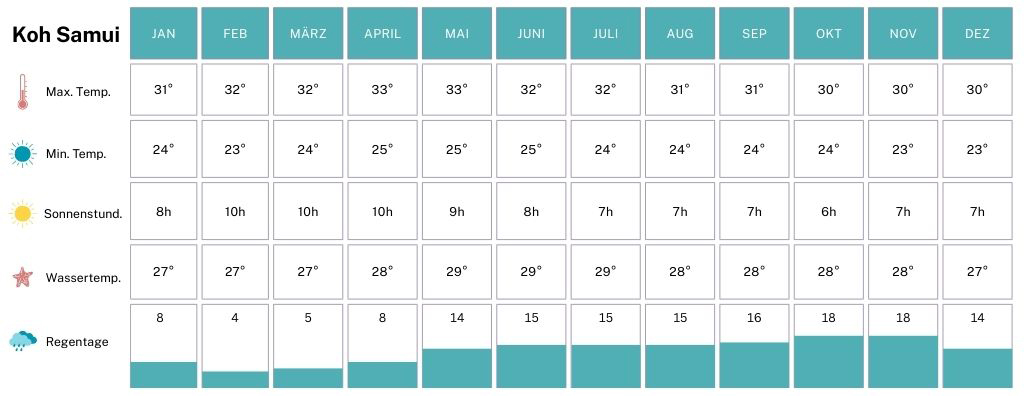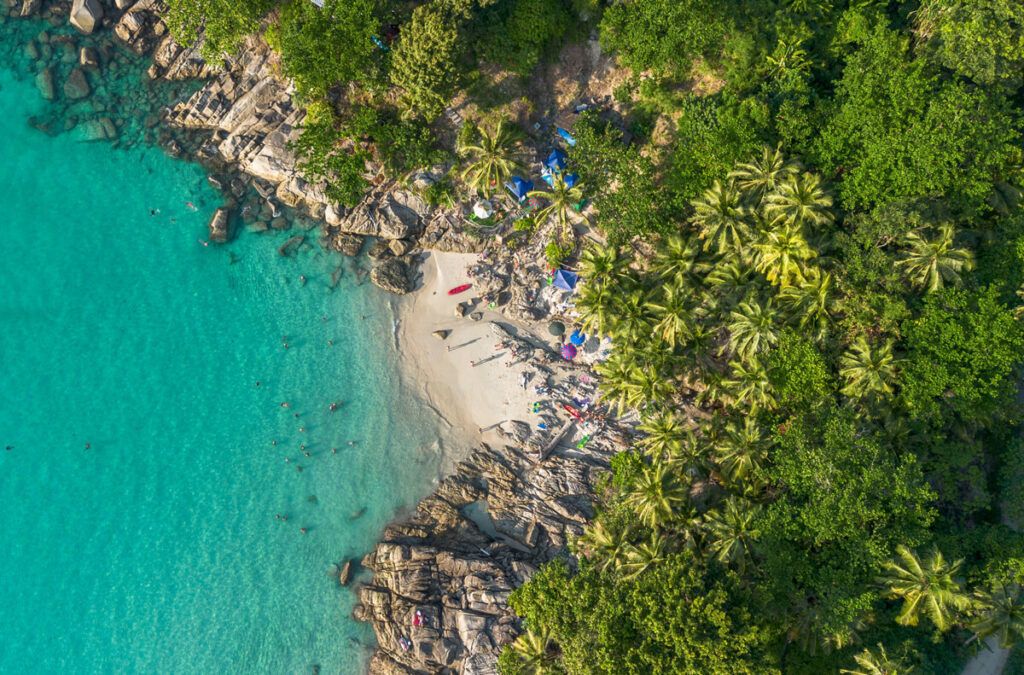Thailand is colorful, bustling, and full of culture – and it’s no longer just a destination for backpackers. Families, couples, and anyone planning their honeymoon are also drawn here. Are you currently planning your trip to Thailand? Then you’ve come to the right place. In this article, we take a closer look at the rainy season in Thailand – so you know when it’s best to travel to enjoy as much sun and pleasant temperatures as possible.
- When is the rainy season in Thailand?
- Northern Thailand (e.g., Chiang Mai, Chiang Rai)
- Central Thailand (e.g., Bangkok & Ayutthaya)
- Southwest Coast – Andaman Sea (e.g., Phuket, Khao Lak)
- Southeast Coast – Gulf of Thailand (e.g., Koh Samui)
- What is the rainy season in Thailand really like?
- Rainy Season in Thailand: Advantages and Disadvantages
- Tips for Your Trip During the Rainy Season
- Conclusion: Is Thailand Worth Visiting During the Rainy Season?
- FAQs about the Rainy Season in Thailand
When is Rainy season in Thailand?
Island vacation, honeymoon, your first backpacking trip, or a family adventure – no matter why you’re drawn to Thailand: To truly enjoy your trip, it’s worth taking a closer look at the country’s tropical climate. Particularly important in this regard: the rainy season in Thailand. When and where how much precipitation falls influences whether you can spend your days at the beach or your jungle trip in the national park dry.
Generally speaking, the rainy season in Thailand falls from June to October – although this varies from region to region. During this time, you can expect around 12 to 20 rainy days per month. That sounds like a lot, but the short rain showers usually only last 30 to 60 minutes. Afterwards, the sun often shines again – with consistently high temperatures between 28 and 34 degrees Celsius.
Brief & concise: Rainy seasons in Thailand by region

Northern Thailand (e.g. Chiang Mai, Chiang Rai)
In Northern Thailand (around Chiang Mai), the rainy season usually begins in May or June and lasts until October. It rains most in June, July, August, and September. Showers often come in the afternoon or evening, while the mornings are usually still sunny and pleasantly warm—perfect for excursions or temple tours.
Especially during the rainy season, nature here is particularly green, the air is fresh, and the waterfalls are full of water. If you prefer peace and quiet and don’t feel like being in crowded places, this is the perfect time of year.

Central Thailand (e.g. Bangkok & Ayutthaya)
In Central Thailand – especially in Bangkok – the rainy season starts in May and lasts until around October. Most of the rain falls in June, July, and August, usually in the form of short, heavy showers, often in the afternoon. So, while you’re out and about during the day, it’s quite possible that a heavy downpour will suddenly hit—but it rarely rains all day. Especially in a city like Bangkok, where you’ll be outdoors a lot and rely on boats or tuk-tuks, rain can throw your plans into disarray. But don’t worry: Even when it rains, there’s still plenty to experience—from street food markets and huge shopping malls to temples and cafés with a view. The high humidity remains, even though temperatures are usually pleasant between 28 and 34 degrees Celsius. The best time to visit Bangkok is between November and February, when it hardly rains and you can stroll through the city in pleasant temperatures.
On Koh Chang and Koh Kood , the rainy season is from May to October, with August and September being the wettest. During this time, heavy showers can occur daily, many accommodations close, and activities are restricted. However, it is quiet, green, and significantly cheaper.

Southwest coast – Andaman Sea (e.g., Phuket, Khao Lak)
Between July and September, the weather along the southwest coast is most changeable. Many popular destinations on the Andaman side (Phuket, Krabi, Koh Lanta, and Koh Phi Phi) experience heavy rainfall during this time. The most rain falls between July and September—it can sometimes rain several times a day, with strong winds, rough waves, and limited ferry service.
If you want to play it safe, the dry season from November to April is the optimal time to travel—especially for island hopping or beach holidays. Many resorts even take a break or offer significantly reduced prices during the rainy season. Some beaches are also difficult to reach or unsuitable for swimming due to the currents. Nevertheless, there are sunny spells between the showers here too – they’re just more unpredictable than in other regions.
Our tip: If you’re flexible, have a good hotel with a spa or pool, and don’t want to lie on the beach every day, you can enjoy the tranquility of the off-season. For island hopping or a beach holiday with guaranteed good weather, the southwest coast is better suited between November and April.

Southeast coast – Gulf of Thailand (e.g. Koh Samui)
In the late rainy months, there can be short thunderstorms, sometimes with strong gusts or flooded streets. Usually, the showers only last 1-2 hours – so no reason to panic, but perhaps time for a relaxing day in the hotel with a massage or a book on the balcony.
The infrastructure on Koh Samui & Co. is great even in the off-season – restaurants, shops, and activities generally continue to operate. You just have to be careful in strong winds or storms, as things can get a bit uncomfortable. If you’re traveling in the European summer, the Gulf Coast with Koh Samui, Koh Phangan, or Koh Tao is the perfect choice.

What does the rainy season in Thailand really look like?
At first, the rainy season sounds like gray skies, constant rain, and soggy flip-flops. But it’s not quite that bad in Thailand—quite the opposite. Many people have completely wrong ideas about the “rainy season.” So let’s be clear:
A typical rainy day in Thailand usually means short, heavy showers that come suddenly and disappear just as quickly. It usually rains in the afternoon or evening, sometimes at night. The morning often starts sunny—ideal for excursions, temple visits, or a few hours on the beach.
When it rains, it rains hard: A monsoon downpour pours down in buckets, floods the streets, and then disappears again as if nothing had happened. Afterwards the sun usually comes out again straight away – only the humidity remains and makes it quite muggy.
Important to know:
- There is still sun – even in the rainy season
- Temperatures remain high (often 28–32 °C)
- Humidity rises, but you get used to it
- Umbrellas are of little use, a light rain cape is more practical
- Weather apps? Mostly pointless – they almost always show rain, even if it only pours briefly once a day.

Rainy season in Thailand: Advantages and disadvantages
The rainy season is not automatically a travel no-go. On the contrary – there are some pretty good reasons to fly to Thailand during this time. Sure, you’ll have to make a few compromises, but with the right expectations, it can actually be quite relaxing.
Advantages of the rainy season:
- Fewer tourists: The hotspots are emptier, temples and beaches less crowded.
- Cheaper prices: Flights, accommodations, and tours are often significantly cheaper than in the high season.
- Everything is green: Nature blooms – rice fields, jungles, waterfalls… truly lush and vibrant.
- More authentic travel: Less hustle and bustle = more real encounters with locals.
Disadvantages of the rainy season:
- More rain (of course): Sometimes daily, sometimes only every few days. And you never know exactly when it might hit you.
- Roads can be impassable: Especially in rural areas or after prolonged rainfall.
- Boats run irregularly: Especially on the Andaman coast (e.g., between Krabi and Koh Phi Phi).
- More mosquitoes around: Keyword mosquito spray – be sure to pack it!
So if you mainly want to chill out, explore temples, or stroll through cities, the rainy season can actually be a secret advantage. Only if you’re looking to island-hop on the west coast or enjoy daily outdoor adventures without a plan B is the dry season a safer option.

Tips for your trip during the rainy season
Rainy season doesn’t mean you have to stay put in your hotel room – but a little preparation and flexibility doesn’t hurt. Here are a few tips to help you have a great time in Thailand, even when it rains:
1. Packing List
- Light rain cape or poncho – much more practical than an umbrella
- Quick-drying clothes and sandals that can get wet
- Dry bag or zip pouch for your cell phone, camera, and important documents
- Mosquito repellent – the bugs are especially active after a rain shower
- Power bank – power outages can occur during thunderstorms
2. Flexible Planning
Simply postpone your daily plans a bit: It’s often dry in the morning – perfect for excursions or sightseeing. In the afternoon or evening, you can sit in a café, have a massage, or relax and stroll through the markets if it’s raining.
3. Your accommodation
A beautiful bungalow right on the beach sounds tempting – but if it’s raining constantly, you might prefer:
- A hotel with a pool, spa, or gym so you have something to do even when the weather is bad
- Central location, for example if you’re in Bangkok – short distances are worth their weight in gold when it rains
- Good infrastructure (restaurants, supermarket, cafes nearby)
4. Activities in Rainy Weather
- Cooking class, Thai massage, temple visit, indoor markets
- In Chiang Mai: creative workshops (e.g., batik, pottery, cooking school)
- In Bangkok: rooftop bars in the evening – the rain has often already stopped by then
Powered by GetYourGuide
Conclusion: Is Thailand worth visiting during the rainy season?
Yes, Thailand can be worthwhile even during the rainy season – if you know what you’re getting into. You have to expect spontaneous showers, humid air, and sometimes limited transportation. But in return, you get empty beaches, green landscapes, and often significantly cheaper prices.
FAQ about the rainy season in Thailand
You should especially avoid September and October, as this is when the rainy season reaches its peak in many regions of Thailand.
The rainy season in Thailand is usually worst in September, followed by October – then it rains particularly frequently and heavily, especially in the center, north, and on the west coast.
No. Usually, there are only short, heavy showers – often in the afternoon or evening. It is often sunny before and after these showers.
Yes, but choose your region carefully. The Gulf Coast (e.g., Koh Samui) is ideal at this time – it can rain heavily on the Andaman Coast.
Depending on the region, about 12 to 20 days per month – but often it only rains briefly.
Yes, especially if you like green nature, fewer tourists, and a bit of adventure. Caution is only advised when hiking or in the mountains.
Lightweight, breathable, quick-drying. Add a rain cape and good mosquito repellent – that’s enough.